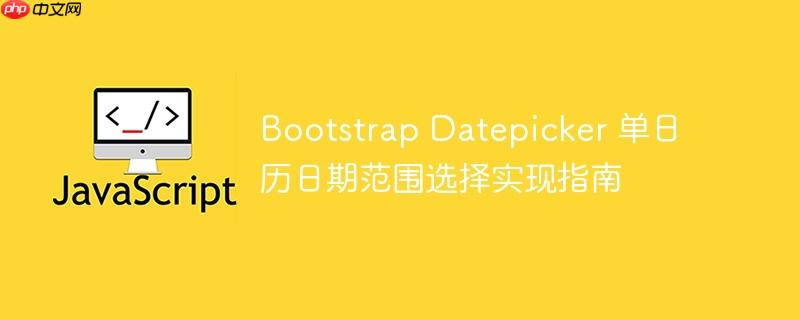
本教程详细介绍了如何利用 bootstrap datepicker 实现单日历的日期范围选择功能。通过配置 multidate 选项并结合自定义的 changeDate 事件处理逻辑及 beforeShowDay 函数,用户可以在一个日历视图中直观地选择并高亮显示起始和结束日期,从而实现简洁高效的日期范围选择体验。
1. 背景与挑战
bootstrap datepicker 是一个广受欢迎的日期选择插件,常用于表单中的日期输入。默认情况下,如果需要实现日期范围选择,通常会使用 input-daterange 结构,它会将两个独立的输入框关联起来,并可能弹出两个独立的日历视图,分别用于选择开始日期和结束日期。然而,在某些场景下,用户可能更倾向于在一个日历视图中完成日期范围的选择,即点击第一个日期作为开始,点击第二个日期作为结束,并高亮显示两者之间的所有日期。这需要对 datepicker 的默认行为进行一些定制。
2. 实现原理
要实现单日历日期范围选择,核心思路是利用 Bootstrap Datepicker 的 multidate(多选日期)功能,并在此基础上添加自定义逻辑来限制选择的日期数量(最多两个),处理日期的排序,以及通过 beforeShowDay 回调函数实现日期范围的高亮显示。
具体步骤如下:
- 使用单个输入框: 不再使用 input-daterange 结构,而是绑定一个标准的 <input type=”text”> 元素。
- 启用多选: 将 multidate 选项设置为 true,允许用户选择多个日期。
- 定义多选分隔符: 设置 multidateSeparator,它将用于在输入框中显示选定的多个日期,例如 “yyYY-MM-DD – YYYY-MM-DD”。
- 限制选择数量: 在 changeDate 事件中,检查当前选定的日期数量,如果超过两个,则只保留最后两个日期。
- 排序日期: 确保选定的两个日期始终按时间顺序排列(开始日期在前,结束日期在后)。
- 高亮显示范围: 使用 beforeShowDay 回调函数,根据已选择的开始和结束日期,为范围内的所有日期添加特定的 css 类,从而实现视觉上的高亮效果。
3. 代码实现
3.1 引入必要的库和样式
首先,确保你的 html 页面中已经引入了 jquery 和 Bootstrap Datepicker 的 CSS 和 JavaScript 文件。
<!DOCTYPE html> <html lang="zh-CN"> <head> <meta charset="UTF-8"> <meta name="viewport" content="width=device-width, initial-scale=1.0"> <title>单日历日期范围选择</title> <!-- Bootstrap Datepicker CSS --> <link href="https://cdnJS.cloudflare.com/ajax/libs/bootstrap-datepicker/1.8.0/css/bootstrap-datepicker.css" rel="stylesheet"/> <style> /* 定义高亮样式 */ .highlighted { background-color: #99ccff; /* 浅蓝色背景 */ border-radius: 3px; /* 轻微圆角 */ } </style> </head> <body> <div style="margin: 50px;"> <h3>选择日期范围</h3> <!-- 单个日期输入框 --> <input type="text" id="date" class="form-control" placeholder="请选择日期范围"> </div> <!-- jQuery --> <script src="https://ajax.googleapis.com/ajax/libs/jquery/2.1.1/jquery.min.js"></script> <!-- Bootstrap Datepicker JS --> <script src="https://cdnjs.cloudflare.com/ajax/libs/bootstrap-datepicker/1.8.0/js/bootstrap-datepicker.min.js"></script> <!-- Datepicker 汉化文件 (可选) --> <!-- <script src="https://cdnjs.cloudflare.com/ajax/libs/bootstrap-datepicker/1.8.0/locales/bootstrap-datepicker.zh-CN.min.js"></script> --> <script> // JavaScript 代码将在这里添加 </script> </body> </html>
3.2 JavaScript 配置与逻辑
接下来,添加用于初始化 Datepicker 并处理日期选择逻辑的 JavaScript 代码。
$(document).ready(function() { // 初始化 Datepicker $('#date').datepicker({ startView: 0, // 初始视图模式,0 = 月视图 minViewMode: 0, // 最小视图模式,0 = 日 maxViewMode: 2, // 最大视图模式,2 = 年 multidate: true, // 启用多选功能 multidateSeparator: " - ", // 多选日期在输入框中的分隔符 autoClose: true, // 选择日期后自动关闭日历 // beforeShowDay 回调函数,用于自定义日期的样式 beforeShowDay: highlightRange, // language: 'zh-CN' // 如果引入了汉化文件,可以设置语言 }).on("changeDate", function(event) { // 当日期改变时触发的事件 var dates = event.dates; // 获取当前所有选定的日期数组 var elem = $('#date'); // 避免重复处理,如果选定日期没有变化则直接返回 if (elem.data("selecteddates") === dates.join(",")) { return; } // 如果选定的日期超过两个,则只保留最后两个 if (dates.length > 2) { dates = dates.splice(dates.length - 1); // 移除除了最后一个之外的所有日期 } // 对选定的日期进行排序,确保开始日期在前,结束日期在后 dates.sort(function(a, b) { return new Date(a).getTime() - new Date(b).getTime(); }); // 将处理后的日期重新设置回 Datepicker,并更新 input 框显示 // 同时将当前选定日期存储在 data 属性中,用于下次比较 elem.data("selecteddates", dates.join(",")).datepicker('setDates', dates); }); // beforeShowDay 回调函数实现日期范围高亮 function highlightRange(date) { var selectedDates = $('#date').datepicker('getDates'); // 获取当前 Datepicker 中选定的日期 // 如果已经选择了两个日期,并且当前日期在选定范围之内,则添加 'highlighted' 类 if (selectedDates.length === 2 && date >= selectedDates[0] && date <= selectedDates[1]) { return { classes: 'highlighted' }; } // 否则不添加任何特殊类 return {}; } });
4. 注意事项
- 库版本: 确保使用的 jQuery 和 Bootstrap Datepicker 版本兼容。本示例使用的是 jQuery 2.1.1 和 Bootstrap Datepicker 1.8.0。
- CSS 样式: highlighted 类是自定义的,你可以根据自己的设计需求调整其样式。
- 用户体验: 此方案通过点击两次来选择范围,第一次点击选择开始日期,第二次点击选择结束日期。如果用户第三次点击,则会清空前两个日期,重新开始选择。这种行为需要用户习惯。
- 日期格式: Datepicker 的日期格式可以通过 format 选项进行配置,例如 format: ‘yyyy-mm-dd’。本示例未显式设置,将使用 Datepicker 的默认格式。
- 清除选择: 如果需要提供一个清除按钮来清空已选的日期范围,可以调用 $(‘#date’).datepicker(‘clearDates’); 方法。
5. 总结
通过上述方法,我们成功地将 Bootstrap Datepicker 从默认的单日选择或双日历范围选择模式,改造为在一个日历视图中实现日期范围选择的功能。这种方式不仅节省了屏幕空间,也为用户提供了更直观、更一体化的日期范围选择体验。核心在于灵活运用 multidate、multidateSeparator、changeDate 事件以及 beforeShowDay 回调函数,通过 JavaScript 逻辑来控制选择行为和视觉反馈。


评论(已关闭)
评论已关闭